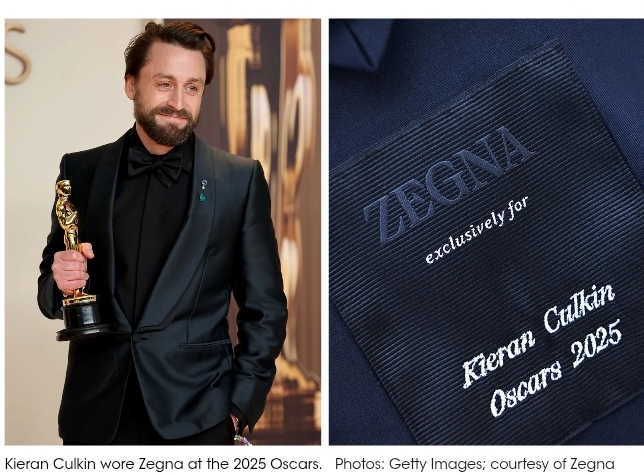Zegna Group’s DTC Growth Strategy Shines Amid Wholesale Challenges and Global Uncertainty
The Ermenegildo Zegna Group, home to luxury fashion brands Zegna and Thom Browne and licensee of Tom Ford Fashion, has revealed a resilient performance for Q1 fiscal 2025. While total group revenues declined slightly by 1% year-on-year to €458.8 million, a strategic focus on direct-to-consumer (DTC) growth helped counterbalance weaknesses in wholesale. As a result, Zegna Group’s shares rose 2% in pre-market trading.
Despite external headwinds, the company delivered encouraging signs of strength in its DTC channel. Across all three brands, DTC revenues rose 5.2% year-on-year, reaching €345.1 million. This shift demonstrates Zegna Group’s strategic clarity in building customer-centric, brand-owned experiences. It also signals a clear commitment to enhancing control over its customer journey, from discovery to conversion.
Zegna’s DTC Momentum Leads the Way
Zegna, the group’s flagship brand, saw DTC sales climb 4.7% year-on-year to €250.8 million. Total revenues for the brand rose 3.6% to €292.9 million. Notably, this growth came amid geopolitical and economic uncertainties, which the leadership acknowledged but did not allow to derail strategy.

CEO Ermenegildo “Gildo” Zegna remarked, “We are encouraged by these early positive results, but also mindful of the recent geopolitical and economic uncertainties… What truly matters is the strength of our brands and our unwavering commitment to staying close to our customers.”
This statement reflects Zegna Group’s CX-first philosophy. Instead of reacting with panic to macroeconomic headwinds, the group has doubled down on building long-term brand value by enhancing DTC capabilities.
Tom Ford Fashion Sees Double-Digit DTC Growth
Tom Ford Fashion emerged as a standout performer, with DTC sales up 10% to €48 million, and total revenues up 3.8% to €67.5 million. This growth came after Haider Ackermann’s acclaimed March debut for the brand, which drew significant attention across fashion media and consumers alike.
Clearly, creative reinvention and direct engagement go hand-in-hand. The combination of artistic innovation and personalized customer experiences led to real business impact.
Thom Browne Faces Headwinds, But Holds DTC Gains
In contrast, Thom Browne’s overall revenue dropped 18.9% to €64.2 million, primarily due to a 48% drop in wholesale revenues. However, DTC sales rose 3.5% to €46.2 million, reflecting strong customer loyalty and brand resonance, despite broader channel restructuring.
The group attributed the wholesale decline to a deliberate move to streamline and rebalance the channel, aligning with a longer-term vision of CX control and brand consistency.
Regional Trends Underscore DTC Significance
Breaking down regional performance offers further insight into why DTC excellence matters.
- EMEA, Zegna Group’s largest market, fell 1.6% to €154 million, mainly due to Thom Browne’s decline.
- Greater China dropped 11.6% to €123.3 million, yet signs of recovery are visible. Positive reactions to new product drops and initiatives are emerging.
- The rest of APAC rose 6.5% to €55.9 million, fueled by strong results in Japan and Singapore.
- The Americas delivered the strongest regional performance, growing 9.5% to €125 million. Here, Zegna led the charge with double-digit brand growth, bolstered by the Spring/Summer 2025 collection.
These regional dynamics reinforce one thing: localized CX strategies matter. While macro factors influence demand, personalized engagement, relevant collections, and seamless DTC operations can still drive success.
Tariffs and CX: Staying the Course with Italian Craftsmanship
On the topic of tariffs, group COO and CFO Gianluca Tagliabue clarified the company’s position. Despite the recent 10% tariff hike on US imports, Zegna Group remains committed to sourcing from Italy.
“We are definitely not thinking about moving any activities of manufacturing [to] the US,” he said. “That is not feasible.”
Zegna views “Made in Italy” not just as a label, but as a core brand value. For customers, this authenticity translates into trust, quality, and storytelling—elements essential to premium CX. Even with cost pressures, the company plans to respond with modest price adjustments rather than diluting its brand promise.
For Winter 2025, Zegna may implement a mid-single-digit price increase in the US. However, this change is strategic, not reactive. It ensures the company protects margins while continuing to invest in customer experience and product innovation.
What This Means for the CX World
Zegna Group’s Q1 2025 performance delivers key lessons for CX leaders and retail brands worldwide:
- Direct-to-consumer is not optional—it’s essential.
DTC empowers brands to control messaging, customer service, personalization, and data insights. Zegna’s 5.2% DTC growth reflects its CX maturity. - Creative leadership fuels engagement.
The Tom Ford Fashion rebound proves that when artistry aligns with execution, customer loyalty and buzz follow. - Wholesale rationalization must be strategic.
While Thom Browne faced short-term pain, it’s part of a broader plan to future-proof the brand through better CX control. - Tariff decisions should not compromise brand authenticity.
By holding onto its Italian heritage, Zegna shows that customer trust outweighs short-term cost concerns. - CX excellence must be regionally tailored.
APAC’s rise and the Americas’ resilience underscore the need for localized engagement strategies that reflect market nuances.
Final Thoughts
Zegna Group has made it clear: resilience starts with CX. While revenue pressures and global uncertainties persist, the group’s sharp DTC focus and customer-first culture are paying off.
With a robust product pipeline, continued innovation in customer engagement, and unwavering commitment to brand heritage, Zegna stands well-positioned for future growth.
For those in the CX world, Zegna’s playbook offers a powerful reminder:
When brands truly listen to and invest in their customers, they not only survive — they thrive.

